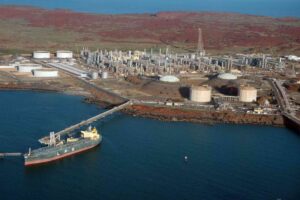Two vital questions for Australia are the extent to which climate change impacts in China could damage the Australian economy, and the regional strategic consequences should climate impacts in China undermine domestic political stability.
Australia faces severe consequences if China’s economy grows at a significantly lower rate, or falls into recession. China is Australia’s largest trading partner and overseas market for Australian resources, services and agriculture, representing over a quarter of all Australian exports at $85.9 billion in 2015-2016.
Two-way China–Australia trade is more than twice that of our next largest trading partner, Japan. The relationship with China represents Australia’s largest dependence on any one nation since the UK in the 1950s.
In addition, while China ranks third for foreign investment in Australia, future increases in investment from China are central to the prosperity of many Australian industries, such as agriculture and construction.
Modelling from Deloitte’s Access Economics, released by economist Chris Richardson, shows that a slowing of China’s growth rate from 6.5% to 3% would effectively cause a recession in Australia.
There would be a loss of 500,000 jobs, a 9% drop in house prices costing Australian families $600 billion, and a 17% share market drop costing $300 billion. Construction and mining sectors would be hit the hardest, resulting in a housing market crash, and a drop in iron ore exports. Iron ore, the biggest component of Australian exports to China, is extremely sensitive to economic conditions.
Victor Shvets of Macquarie Bank describes a Chinese economic downturn or “collapse” as inevitable due to the “misalignments” of resources and the affected return on investment and equity. While the timing of a Chinese downfall cannot be accurately estimated, Shvets says that any collapse would have severe ramifications due to China’s central role in the global economy.
China currently controls 15 per cent of global trade, 30 per cent of global savings and more than 30 per cent of global investment. However, China is experiencing record debt levels: its debt to GDP ratio stands at an eye-watering 277 per cent; there is a large and opaque “shadow banking” system; and “no nation has ever emerged from such a debt-fuelled growth binge in such a short space of time without a serious lift in bad debts, and a deep recession”, says business commentator Ian Verrender.
There are growing fragilities in the China’s economy: it is changing focus from the export to the consumption sector, the working-age population is shrinking, state-owned enterprises, competition is increasing from lower-cost developing nations, and there is increasing pressure on wages for unskilled workers.
A downturn in the Chinese economy could be triggered or heightened by climate change events. Increased natural disasters, growing water shortages impacting the agricultural sector, the threat of rising sea levels on low-lying cities and industries including agriculture, and damage to infrastructure from extreme events are just some of the potential impacts. Some key issues are:
-
Infrastructure hotspots: Research has identified infrastructure hotspots in China, including Beijing, Shanghai, Tianjin, Zheijiang and Jiangsu, that are most vulnerable to economic impacts from climate change. Critical hotspots include zones of concentrated critical infrastructure on which large numbers of people are dependent, and include transport systems, water treatment centres and power plants. Unprecedented incidents, including frequent power outages, intermittent water supply, transport cancellations, production losses, property damage and industrial accidents, are likely to impact both individuals and companies. The Thailand floods in 2011 are an example of the economic ramifications of climate change events: manufacturing plants, including Toyota and Honda, were closed for months, and the disaster represented 80% of the world’s total economic losses for the same year. A similar event in China would likely have even greater global consequences due to China’s manufacturing dominance in the global supply chain.
-
Water insecurity: China comprises 20% of the global population but has only 7% of available fresh water. Changing climate patterns, causing droughts and increased desertification, have reduced freshwater reserves by 13% between 2000 and 2009. Twenty-four thousand villages in north and west China have been abandoned due to desertification in the last 50 years: the advancing Gobi Desert is now only 150 miles from Beijing. Three hundred million rural people have no access to safe drinking water, and 54% of the main rivers contain water unfit for human consumption. A World Bank report on China’s water situation foresees catastrophic consequences for future generations unless water use and supply can quickly be brought back into balance. The government also fears that increased competition for water resources between large industries, to whom the majority of water allocations are given, cities and farmers poses a risk of creating social instability.
-
Agriculture: Four-fifths of China’s grain harvest comes from irrigated land, which uses surface water principally drawn from the Yellow and Yangtze rivers, which are fed from the Tibetan Plateau. Irrigated areas are highly vulnerable to changes in water availability. The water table under the North China Plain is falling fast. This is an area that produces half of the country’s wheat and a third of its corn. Overpumping has largely depleted the shallow aquifer and forced well-drillers to turn to the region’s unreplenishable deep aquifer.Wheat yields dropped 4.5% over the period 1979-2000, a loss attributed to climate change. Projections show potential reduction in cereal output of up to 18% by 2040 compared 2000. Such consequences would mean that China will lose the ability to feed about 10% of its 1.3 billion people.Major droughts in China and Russia in 2010 devastated local wheat production, driving up international prices and in some cases tripling the price of bread in Egypt and across the Maghreb in 2010-2011. This caused major food riots and became a driver of the Arab Spring. An increased likelihood of crop failure in China has the capacity to again disrupt international grain markets, and the stability of nations.
-
Inundation of primary manufacturing zone: China’s Pearl River Delta special industrial zone, which includes the cities of Guangdong and Shenzhen, is responsible for 20% of national GDP, more than 30% of foreign direct investment, and 40% of China’s exports. In 2012, Guangdong handled more than 1.2 billion tonnes of freight. However, this area is less than two metres above sea level, and built on a sinking delta, and is very vulnerable to both rising sea levels and storm surges caused by cyclones. The region is home to the greatest number of people (after Kolkata) estimated to be at risk of flooding anywhere in the world.A 2013 study researched coastal defenses and their level of protection, and found that, in terms of the overall cost of damage from inundation and rising sea levels, Guangzhou was the city at the greatest risk while Shenzhen was ninth most vulnerable. “Hard” defences are not considered to be feasible , however, the question of the Pearl River Delta’s vulnerability to cyclone-driven storm surges and rising sea levels is pertinent. Waters in the South China Sea and Philippines are considered to be “Cyclone Alley” highlighted by Cyclone Haiyan, which hit the Philippines in 2013, and was the strongest cyclone on record to make landfall anywhere in the world.In understanding the vulnerability of the Pearl River Delta, it is important to recognise that climate change has already likely triggered the collapse of the West Antarctic Ice Sheet (WAIS), with loss of a significant fraction of WAIS on a decadal to century time-scale, and Antarctica alone could contribute more than a metre of sea-level rise by 2100. The US Department of Defence is now using sea-level rise scenarios of 1 and 2 metres by 2100 and a US government agency has just lifted its maximum sea-level rise estimate to 2.5 metres by 2100.
-
Internal migration: Changes to regional precipitation patterns, resource scarcity and agricultural productivity have been identified as drivers of internal migration in China and are likely to accelerate in the future. Internal migration most commonly occurs from rural to urban areas where people are often forced into urban slums, creating social issues and conflict between internal migrants and those already settled. This contributes to the danger that government will be unable to cope with rapidly swelling urban populations and large amounts of displaced people, particularly in the event of natural disasters or delta and coastal inundation.
China’s vulnerability to such climate impacts should be of urgent concern to the Australian Government. Imagine the following scenario:
In China’s north, a water crisis deepens with overexploitation of groundwater, reduced irrigation capacity, and a two-year northern monsoon failure. A political crisis develops in rural communities, strengthened in the north-west by long-standing grievances among the Muslim minority, and there is significant internal migration to the large cities. A category 5 typhoon hits the Pearl River Delta/Guangdong free-trade zone, and storm surges inundate half of the delta, destroying infrastructure and significantly disabling export capacity for up to a year.
Consequently, the Chinese economy stalls and tips into recession, while chronic and opaque debt, especially in the state sector, cascades into a full-blown credit crisis. The crash infects Asian markets, and Australian banks are exposed. As Chinese output stagnates, Australian resource exports fall, putting further pressure on a fragile Australian domestic stock market.
Chinese employers try to replace organised labour with new migrants from the countryside, but workers resist, especially in unionised overseas firms in the Guangdong zone, and labour disputes escalate. The middle class joins the revolt as they lose out from over-leveraged stocks in a plunging share market. An internal political crisis gathers strength, and other parties decide to test Chinese sovereignty claims in the South China Sea.
The economic and strategic implications for Australia would be profound, but it is difficult to find evidence that the Australian Government has assessed the consequences in any systematic way.









